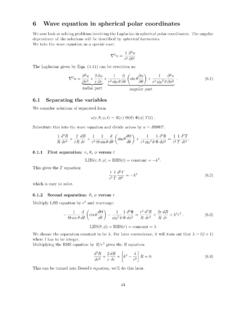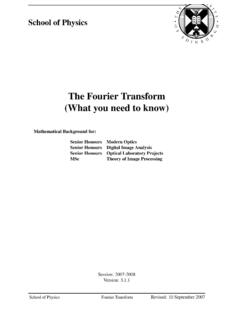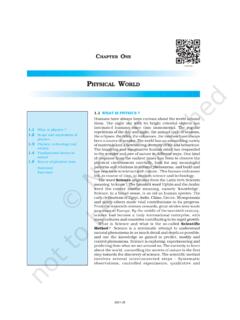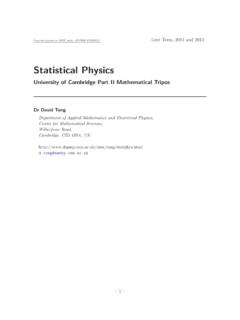Transcription of Quantum Electrodynamics - School of Physics and Astronomy
1 Quantum Electrodynamics Outline Outline classical versus Quantum Theory Force/interaction mediated by exchange of field quanta Virtual Particles Propagator Feynman Diagrams Feynman Rules Matrix Elements Cross sections Electromagnetic vertex Coupling strength Coupling constant Conservation laws QED processes Electron-proton scattering Electron-positron annihilation Higher order Diagrams Precision QED tests Running of alpha Dirac Equation Appendix Nuclear and Particle Physics Franz Muheim 1. Quantum Electrodynamics Quantum Theory (QED). of Electromagnetic Interactions classical Electromagnetism Forces arise from Potentials V(r). act instantaneously at a distance QED Picture Forces described by exchange of virtual field quanta - photons Propagator Matrix element Full derivation in 2nd order perturbation theory Gives propagator term 1/(q2 - m2) g2.
2 M fi = 2. for exchange boson (q m 2 ). Equivalent to scattering in Yukawa potential Nuclear and Particle Physics Franz Muheim 2. Virtual Particles Electromagnetic Interaction Forces between two charged particles are due to exchange of virtual photons Example: electron-electron scattering: q2 e- e- e- e- Photon mediates electromagnetic interaction . No action at a distance required! Virtual Particles Do not have mass of physical particle r m X2 E X2 p X2. known as Off mass-shell . non-zero for photon r 4-momentum of virtual particle q = ( E q , q ). is energy and momentum transfer between scattered particles Virtual mass-squared q2 = EX2 - pX2. q2 > 0 and q2 < 0 possible Propagator - how far particle is off mass-shell Internal lines, not observable must observe E t . Nuclear and Particle Physics Franz Muheim 3.
3 Feynman Diagrams A Feynman diagram is a pictorial representation of a process corresponding to a particular transition amplitude Aitchison & Hey Gauge Theories in Particle Physics . Basic Principle Transition amplitude for all processes - scattering, decay, absorption, emission - is described by Feynman Diagrams Feynman diagrams a most useful tool in modern particle Physics and will be used a lot in this course! Conventions Time flows from left to right (sometimes upwards). Fermions are solid lines with arrows Bosons are wavy or dashed lines Feynman Rules Allow to calculate quantitative results of transition Derived from Quantum field theory (QFT). Nuclear and Particle Physics Franz Muheim 4. Electromagnetic Vertex QED Feynman Diagram Initial state fermion Absorption or emission of photon Final state fermion Examples: e- e- Bremsstrahlung e- + e- Photoelectric effect All electromagnetic interactions are described by vertex and photon propagator Coupling Strength Transition amplitude proportional to fermion charge Mfi e Probability/rate of emission or absorption rate |Mfi|2.
4 Rate proportional to coupling constant . Coupling Constant CouplingConstant Coupling Constant e2 1. Fine structure constant = 4 hc 137 SI. e2. 0. QED Conservation Laws Momentum and energy conserved at all vertices Charge is conserved in all QED vertices Fermion flavour is conserved e- e- exists, but not c u . QED vertex also conserves parity Nuclear and Particle Physics Franz Muheim 5. Basic QED Processes Initial and final state particle satisfy relativistic four-momentum conservation m2 = E2 - p2. In free space - Energy conservation violated for above diagrams if all particles are real Nuclear and Particle Physics Franz Muheim 6. Feynman Rules for QED. Each line and vertex in Feynman diagram corresponds to a term in the matrix element Initial and final state fermions Fermion wave function (spinor when including spin).
5 Initial and final state bosons Boson wave function includes polarisation Internal virtual photons Photon propagator 1/(q2 - m2) = 1/q2. Internal fermions Spinor propagator exchanged between charged particles similar in structure to photon propagator Vertex Coupling constant ~ e Example: electron-muon scattering: e- - e- - Transition amplitude iM fi = u4 ie u2 muon current ig . photon propagator q2. u3 ie u1 electron current and g are 4x4 matrices account for spin-structure of electromagnetic interaction Nuclear and Particle Physics Franz Muheim 7. Electron-Proton Scattering Matrix Element e- p e- p Transition Amplitude use Feynman rules simple if neglecting spins 1 e 2 4 . M e 2 e= 2 = 2. q q q Cross section Probability for scattering d 2 e 4 16 2 2. M 4 =. d q q4. 4-momentum transfer (. q 2 = q q = p f pi ).
6 2. = p 2f + pi2 2 p f pi ( r p f = E f , p f ). (r r = 2me 2 E f E i p f pi cos . 2. ) r pi = ( E i , pi ).. = 4 E f E i sin 2 when neglecting me 2 . Rutherford Scattering RutherfordScattering Rutherford Scattering Elastic Ef = Ei = E, neglect proton recoil d 2. =. d . Lab 4 E 2 sin 4 . 2 . d 2 E f 2 . cos q sin 2 . 2. =. d Lab E 2 2M p 2. 2 . 4 E 2 sin 4 i . 2 . Nuclear and Particle Physics Franz Muheim 8. e+e- Annihilation Matrix element e+e + . Neglecting spin effects q2. 1 e 4 2. M e 2. e= 2 = 2. q q q Cross section Work in centre-of-mass frame 4-momentum transfer r r 2. q 2 = q q = ( E1 + E 2 ) ( p1 + p2 ) = ( 2 E ) 2 = s 2. Use Fermi's Golden Rule, density of final state normalisation of wave function d E2 2. = 2 M. 2. =. d CoM (2 )3 s t 2 + u2. Correct treatment of spins M. 2. = 2e 4. s2. d 2. =. d CoM 4 s (.)
7 1 + cos 2 ). 4 2. (e e ). + + 87 nb = =. 3s [. s GeV 2 ]. Nuclear and Particle Physics Franz Muheim 9. Higher Order Diagrams QED. time dependent perturbation theory Lowest order 1. M 2 . 2. 137 2. Second order 1. M 4 . 2. 137 4. Higher orders Order n suppressed by = 1/1372n Lowest order dominates if coupling constant is small QED converges rapidly Nuclear and Particle Physics Franz Muheim 10. QED Precision Tests Magnetic moment Couples to spin of electron r r eh = g B S where B =. 2m e c Dirac Equation predicts gyromagnetic ratio g = 2. for point-like particles Anomalous magnetic moment a = (g-2)/2. Higher order corrections Bullet represents external electromagnetic field vertex vacuum muon spin-precession polarisation in magnetic field . Vertex ae = a = = 10 3. 2 . 2 loops 7 Feynman diagrams 3 loops 72 Feynman diagrams 4 loops 891 Feynman diagrams QED is most precise theory in Physics Experiment ae = ( ) 10-10.
8 Theory ae = ( ) 10-10 electrons muons Nuclear and Particle Physics Franz Muheim 11. Running of . Coupling constant . Strength of electromagnetic interaction = e2/4 is not a constant at all distances Vacuum Not empty, around free electron creation and annihilation of virtual electron-positron pairs Screening Bare charge and mass of electron only visible at very short distances increases with with larger momentum transfer e+e + . classical limit q2 = 0 = 1/137. At short distances q2 = (90 GeV)2 = 1/128. Nuclear and Particle Physics Franz Muheim 12. Dirac Equation Schroedinger equation 1st order in time derivative 2nd order in space derivatives Klein-Gordon equation 2nd order in space and time derivatives 2 r 2 2 r 2 . 2 + = m 2 or 2 + m 2 = 0. t t . negative energies (E < 0). and negative probability densities (| |2 < 0).
9 Dirac Dirac equation Dirac Equation Equation 1st order in time and space derivatives r r 0 . i . t . + i m = 0 or (i . ). m = 0.. are 4x4 matrices 1 . Solutions of Dirac equation . 2 . Wave function with 4-component spinor = .. 3 .. r (. ( x , t ) = N u( p) exp ip x ) E = p2 + m 2 4 . 2 positive energy solutions, E > 0. 2 negative energy solutions, E < 0. Dirac Equation not examinable Nuclear and Particle Physics Franz Muheim 13.














